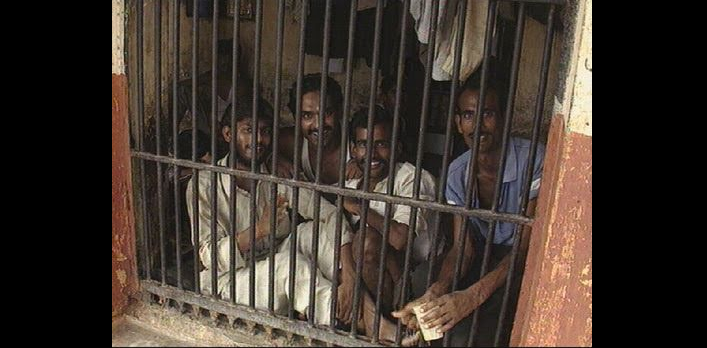Dismal Conditions in Indian Prisons, Sharp Hike in Habitual Offenders

NEW DELHI: Early September, India Today screened footage of men having their feet flogged, being stripped and beaten by sticks. These acts took place in a prison merely 30 kilometers from New Delhi.
On December 20 1979, the Supreme Court of India’s ruling in Sunil Batra vs Delhi Administration recognized the urgent need for prison reform. Sunil Batra a prisoner in Tihar Jail, New Delhi wrote a letter to the Supreme Court regarding the inhuman conditions in prison. Batra brought to notice an incident where a jail warden pierced a baton into the anus of a prisoner.
The court led by Justice Krishna Iyer took cognizance of this letter making clear that technical and legal niceties are no impediments for a habeas corpus petition. In some ways this case recognized for the first time public interest litigation as a tool to protect constitutional rights of the voiceless. The Sunil Batra ruling along with the Judgments of Hussainara Khatoon vs State of Bihar (1979) and Anil Yadav vs State of Bihar brought to the public sphere the urgent need to address the issues of access to courts, right to speedy trial and prison reforms .
Again in 2013, former Chief Justice of India R.C. Lahoti wrote a letter to the Supreme Court bringing to notice a story in Dainik Bhaskar that highlighted the inhuman conditions existing in 1382 prisons. The Supreme Court of India took cognizance of this letter.
Justice Madan B. Lokur and Justice R.K. Aggarwal reading the contents of the letter expressed exasperation at the fact that for 35 years the judiciary has recognized the need for creating more human conditions in prison. And yet nothing seems to have changed.
Nevertheless the court continued to strive for change, the bench raised the problem of overcrowding in prisons. NCRB data of 2013 shows that Muslims, SC and ST populations constitute nearly 39 percent of prison population. These groups account for 53 percent of the under trial prisoners in various jails. Several of the under trials are uneducated and economically backward having no access to legal aid.
On February 5, 2016, after deliberation the court directed that an under trial review committee be set up at every district and should meet every quarter. This committee must insure that under trials that have served their sentence or are entitled to be discharged due to remission must be released. It was also ordered that those who cannot furnish bail bonds due to economic difficulties should not suffer incarceration for such reason. These committees must also specifically see cases of women offenders, first time offenders, the mentally unsound and those who require medical aid etc. It is important that these prisoners are immediately informed of their legal right to bail.
The court also made note that the NCRB data for the year 2013 showed that nearly 68% of the prison population consisted of under trial prisoners! It is a fact that most of these under trials come from socially and economically backward sections and usually do not have access to courts. The court has ordered for the National Legal Service Authority (created under the Legal service authorities act, 1987) to form authorities at district, state and national level for providing legal aid.
Overcrowding remains one of the biggest problems in Indian prisons. Sadly, the situation hasn’t changed in 40 years. Going back to the Hussaina Khatoon (1979) ruling, Justice P.N. Bhagwati faced a similar situation regarding overcrowding of prisons and had directed release of under trial prisoners in Bihar. These prisoners had already served longer periods in prison than they would have if convicted.
Yet, today we face a situation where the extent of overcrowding is such that we are failing to maintain conditions as prescribed under United Nations Standard Minimum Rules for Treatment of Offenders.
The Bench also brought to light the fact that the 13th Finance commission had allocated Rs. 609 crores for improvement of prison conditions. However 19 states are yet to receive grants. And where grants have been received utilization remains a problem. Keeping this fact in view the court also directed that Director General and Inspector General of police should insure proper utilization of funds so living conditions of prisoners progresses.
In recent times attempts have been made by the political class to deal with the issue of overcrowding. In 2002 the “modernization of prisons” plan was passed by the Centre where Rs 1800 crores were allocated to build additional prisons and improve the quality of life of under trials. In the year 2005, the Central Government amended section 436 of the Code of Criminal Procedure, 1973 to deal with the increasing number of under trials in prisons. The amendment stated that if an accused is detained for more than half the maximum period of imprisonment associated with the crime, he/she has the right to be released on the presentation of a personal bond.
However, this is not enough as seen by the little progress made on the ground. There is an urgent need to overhaul the criminal justice system.
This can only happen when structural change is brought about at every level from the process of arrest, investigation, and bail to that of sentencing. What is also worrying is that our prisons are failing to deter and rehabilitate inmates.
NCRB data of 2016 shows a sharp increase in repeat offenders. Currently our prisons are reinforcing criminality rather than rehabilitating the prisoners. For this the state must ensure that individuals in the criminal justice systems have a sociological understanding of crime.
It is essential that along with infrastructural development judicial reforms must develop a plan to rehabilitate prisoners.



